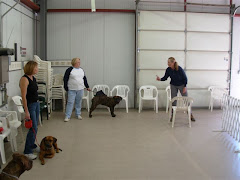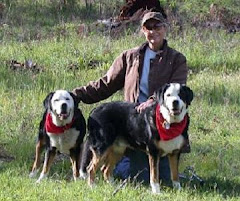You're wondering what one has to do with the other? They're closely related. Let me tell you about my speeding ticket and use it to demonstrate the way I feel about using shock collars for modifying certain behaviors in our dogs.
The cop nailed me as I was coasting down the hill into Lewiston a couple weeks ago. He clocked me at 72 mph in a 60mph zone and slapped me with a fine of $90. It shook me up! I'd tried so hard to stay within the speed limit for the past 200 miles. But for a few seconds I'd let down my guard on the steep grade, and I got caught.
Since then, I've been absolutely paranoid about exceeding the posted speed limit anywhere. I don't care what my peers on the road are doing, I'm going to drive like an old lady because I DON'T WANT TO PAY THE CONSEQUENCES AGAIN.
Now, of course I know that one should not exceed the speed limit anywhere. I understand the law's rationale. But that knowledge seldom stopped me from occasionally drifting over the posted limit.
I've also had a couple warning tickets in my life, and I've seen others pulled over by flashing lights. But none of those is as powerful a deterrent as getting that ticket two weeks ago. That was a painful lesson I won't forget.
Shock collars work the same way. They're not appropriate for all dogs and all problems. But let's say it's a self control problem with a headstrong breed. There's absolutely nothing else wrong with him, other than a lack of self control. He's strong, agile, extremely intelligent, powerful, confident. Like a human teenager, he is controlled by his impulses--or lack thereof. You can "tell" him (train him) nicely not to do certain things, but you can't explain "why." That can only be revealed by the consequences of his actions. If the consequences are unpleasant enough, he'll learn to control his impulses.
The photos below illustrate a dangerous situation that I corrected with a shock collar. Lizzie was chasing the cart horse and actually jumping up to bite his nose, which put everyone in the picture at risk of injury. I put the collar on her, carried the transmitter, and pushed the button when she got within jumping distance of the horse. She immediately learned to leave him alone, but continued to gleefully run alongside and turn to look at him without actually making physical contact. She still loves to run with the horse but is no longer a liability.

 Today's shock collars have adjustable settings, from a mild vibration or a static snap like you get from a carpet in winter, to a jolt you'd get if you touched an electric fence. Just about all humans experience all these "shocks" during our lives, and we live to tell about it. We also remember the bad ones. The worse the shock, the better we remember exactly what we were doing when it happened...and we mentally affirm to never repeat the same action that caused the shock.
Today's shock collars have adjustable settings, from a mild vibration or a static snap like you get from a carpet in winter, to a jolt you'd get if you touched an electric fence. Just about all humans experience all these "shocks" during our lives, and we live to tell about it. We also remember the bad ones. The worse the shock, the better we remember exactly what we were doing when it happened...and we mentally affirm to never repeat the same action that caused the shock.Chasing livestock, chasing a car, or chasing another animal with intent to harm it...those behaviors are all worthy of a correction that sends the dog a clear message: "Never again!" The intensity of the "correction" (yes, a euphemism for "electric shock" ) depends on the size, age, breed and disposition of the dog. It simply needs to be enough to get the point across--the first time--that the chasing action is not worth repeating.
Many novice trainers are understandably leery of using shock collars. If you're not careful and your timing is off, you can inadvertently "correct" your dog for a benign behavior. Let's say, for example, that you want to teach your dog not to chase deer. You see deer at the edge of the yard, and you see your dog bolt in that direction. You assume he's going after the deer, but in fact he hasn't even spotted them yet. You push the button on the shock collar's remote transmitter and give the dog a correction. The dog responds with a startled "Yip" or a little jump, and backtracks. You may find it difficult to get your dog to go into that part of the yard again. It has nothing to do with deer. You've "taught" him that something nasty will happen to him if he goes into that part of the yard again. That's clearly not what you intended to teach him, right?
The time to correct is when the dog has totally committed to whatever behavior you want to stop, but before he has the chance to actually do damage or be hurt himself. Example: you let the dog outside, you see him lock onto the deer and start to run toward them with purpose. His body language tells you he intends to catch the deer if he can, and do them harm. Push the button when you see the dog's natural impulses take over his brain. He may be halfway to the deer, or he may be even closer to them, but he'll be totally focused on the deer. When he feels the shock, he'll assume the deer themselves are "electrified," and he'll develop an instant distaste for them. It usually only takes once. If your timing is off, it may take two episodes to convince him. That's all.
There are many who claim that shock collars are cruel and inhumane. I think it's much more inhumane to allow a dog to be kicked by a horse it was harassing, or hit by a car it was chasing, or put down because it was allowed to attack another dog. Who could argue that one static charge of electricity, strategically delivered at the right moment, is worse than injury or death?
Watch what you read on the Internet. Most of the well-intentioned souls who espouse that shock collars are bad haven't had enough experience with dogs and dog problems to know what they're talking about. Granted, they're not for every dog or every situation. But sometimes--when impulse control means life or death--there's no greater tool.
##
For more on shock collars, check out this older post:
http://janthedogtalker.blogspot.com/2007/12/electronic-collars-should-you-get-one.html






1 comment:
Jan, thanks for posting this- I absolutely agree! I use the shock collar on Magpie, but only activate it when she is doing something dangerous- like jumping at horse noses or being aggressive toward another animal. Usually, the vibration mode is all she needs to "shake the marble back in the hole" and regain her brain!!
Post a Comment